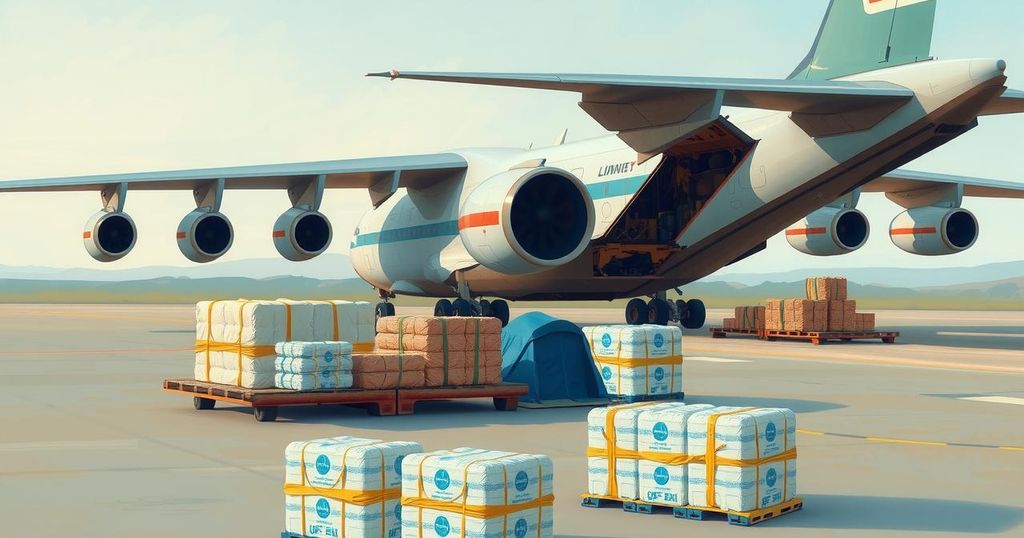Weather
ASIA, EUROPE, FLOODING, FLOODS, GENEVA, HUMANITARIAN AID, INTERNATIONAL AID, ISLAMABAD, ISLAMABAD INTERNATIONAL AIRPORT, JULIA REES, MANDALAY, MARCO, MARCOLUIGI CORSI, MIN AUNG HLAING, MONSOON, MYANMAR, OCHA, PAKISTAN, RADIO PAKISTAN, REUTERS, SHE, SHEHBAZ SHARIF, SWITZERLAND, TAR, TARIQ FAZAL CHAUDHRY, UN AGENCIES, UNICEF, YANGON
Daniel O'Connor
0 Comments
Pakistan Sends 35 Tonnes of Relief Supplies to Earthquake-Hit Myanmar
Pakistan has dispatched 35 tonnes of relief supplies to earthquake-affected Myanmar under Prime Minister Shehbaz Sharif’s directive. The aid includes essential items like food, medicines, and shelter materials. The disaster has resulted in severe casualties and significant humanitarian needs, including shortages of clean water and medical care facilitated by damaged infrastructure.
On Tuesday, the government of Pakistan dispatched a relief consignment of 35 tonnes to Myanmar, which is grappling with the aftermath of a devastating earthquake. This initiative was directed by Prime Minister Shehbaz Sharif, with Minister for Parliamentary Affairs Tariq Fazal Chaudhry overseeing the cargo flight’s departure from Islamabad International Airport, as reported by Radio Pakistan.
The relief package comprises essential supplies such as tents, blankets, tarpaulins, water modules, ready-made food, and medicines. These materials will be handed over to the authorities at Yangon Airport in hopes of alleviating some of the suffering caused by the earthquake.
Following last week’s major earthquake, the death toll has risen to 2,719, with expectations it may surpass 3,000 according to the ruling junta chief, Min Aung Hlaing. He reported that 4,521 individuals sustained injuries, while 441 remain missing after the earthquake, which registered a magnitude of 7.7.
The United Nations’ Office for the Coordination of Humanitarian Affairs (OCHA) highlighted severe shortages of shelter, clean water, and medical supplies in the affected regions. Critical infrastructure, including major roads and bridges, sustained significant damage during the quake, complicating relief efforts, as detailed in a report by Reuters.
OCHA’s Myanmar Resident and Humanitarian Coordinator, Marcoluigi Corsi, remarked that the critical window for search and rescue operations is closing, emphasizing that people are forced to spend nights outdoors due to a lack of electricity and running water.
UN Agencies have sounded alarms over the dire shortage of drinking water, raising concerns regarding potential cholera outbreaks. Julia Rees, Unicef’s Deputy Representative, noted that the heat exacerbates the urgent need for clean water, highlighting the destruction of water systems.
The World Health Organization reported that hospitals are overwhelmed with patients and running low on medical supplies, alongside ongoing shortages of water and fuel. The UN’s refugee agency, UNHCR, identified the situation as a top-level humanitarian crisis and is mobilizing resources such as plastic sheets and mosquito nets.
Relief response efforts have been further complicated due to extensive damage to transportation infrastructure. UNHCR teams reported a journey from Yangon to Mandalay, typically an eight-hour task, now taking up to 13 hours. UNHCR representative Babar Baloch emphasized the urgent need for shelter and relief items, warning of additional risks including unexploded ordnance due to four years of ongoing conflict.
In summary, Pakistan has responded promptly to the humanitarian crisis in Myanmar by sending vital relief supplies following a catastrophic earthquake. The current challenges include managing high mortality rates and injuries, and addressing critical shortages in water, medical supplies, and shelter. UN agencies continue to assess the escalating demands and the impact of damaged infrastructure on humanitarian assistance efforts.
Original Source: www.thenews.com.pk




Post Comment